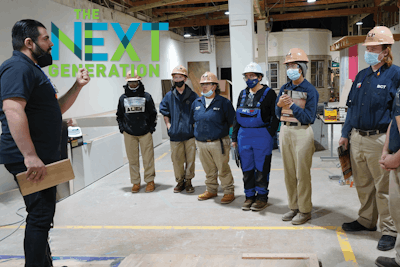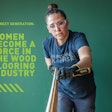
You're a wood flooring contractor. You've just hired a new, seemingly competent helper. Maybe you pump your fist in celebration, maybe you wipe some sweat off your brow—you know that in today's aging industry, finding skilled labor for your business is no easy feat. But now another challenge presents itself: What's next? How do you train this new employee in a way that benefits both of you? WFB spoke with experts on the topic of training a wood floor pro from scratch. They go into detail about what methods have worked for them in not only introducing new talent into the industry, but retaining and inspiring that talent, as well. They also discuss what's changed in training wood floor pros over the years, and how the next generation responds best to learning the trade. So, where do you begin? Scroll on.
1. Vetting: What you need to know
About three months. For many wood floor business owners, this is the time frame in which you can tell whether new hires are going to stick it out or stop answering texts. When you've invested time and resources into training a new hire, having them quit or ghost you soon after can be more than a little discouraging. But the fact is, if you're entering the trade with no experience, there's little way of understanding what a career in wood flooring actually entails until you're in the thick of it. To help all parties get over this critical hump in the road, some contractors have found success by establishing a formal introductory period for new hires.
Probationary period
"Once they're hired, they have a 45-day probationary period," explains Christine Tosland, who, along with her husband Craig, runs Cleveland-based Hazelwood Floors. The Toslands make a point of hiring people with no prior hardwood flooring experience, and they use the probationary period to assign new hires a forman to introduce them to job sites and rudimentary work.
If the trainee hangs on and maintains an interest in the work, Craig introduces them to "the Hazelwood way," a more in-depth training in the trade.
Vibe check
Matt Garcia of San Angelo, Texas-based Craftsman Hardwood Flooring likes to introduce candidates to job sites during the interview process itself. "I like to give them a ride-along, just to show them the job site and get a vibe of how they can fit in with the team," he says. "That's another thing I've really started hiring for: Do they fit in the team? How do they mesh? Is there an attitude clash? Everyone wants to tell you what you want to hear in an interview, and sometimes it's nice just to be able to see how they interact and things like that."
2. Onboarding: What they need to know
As important as it is to understand the person you're hiring and their intentions, setting a new hire's expectations beyond just the technical aspects of the craft can be equally critical to them pursuing a career in the trade.
Future entrepreneurs
Carlos Mongalo, program director at the National Flooring Contractors Apprenticeship Program (NFCAP), has found that tapping into a young person's entrepreneurial side has been key to generating interest in learning wood flooring.
"I tell them we're going to do a 1,000 square foot home, we charge the client $3 a square foot for installation," Mongalo explains. "So we're looking at a $3,000 project. You're willing to work for $50 an hour, that's about $400. I let them know, the guy that gets paid $50, he's the foreman. The foreman's going to take care of the job. For $400 in three days, you're looking at $1,200 for a three-day project. Then I'm going to give the foreman a helper, at $20 an hour. That's $600. So I add that: $1,200 plus $600. That's $1,800 and I subtract it from the $3,000. That comes out to a profit of $1,200. I tell them, You guys don't have to go to work every day. You're happy with the $50, you're happy with the $20. The owner of the floor company is happy because they don't have to be there and just made $1,200. And students then see this whole different picture to the game. I tell them, 'This is entrepreneurship. This is being a contractor.'"
Presenting clear opportunities for advancement
As the Toslands built Hazelwood Floors, it was important to them that they make sure a path for advancement in the company was clear and available to their employees. "We have a little bit of a hierarchy system," Christine Tosland explains. "When you're first starting out, you're trying to learn a trade, and you eventually move from being an apprentice to being a foreman. And in order to be a foreman, you have to take a foreman test, and on top of that, you have to pass a handwritten test that we wrote, understanding not just flooring techniques, but also sales. And then once they're ready for that and once they have done a number of jobs on their own where they're the lead, they take this test; once they pass that test, they're officially a foreman and they get a plaque and a different colored shirt. Our black shirts are our foremen, and they're very coveted—it's a big deal for the guys."
Spelling out the opportunities and giving employees something specific to work toward has also been a successful strategy for Garcia at Craftsman Hardwood Flooring.
"The first thing I really want to show them when they get hired is a career path," Garcia says. "I want to show them potential. We actually do our work orders on a spreadsheet, and it calculates their payment by the hour, but we also run a bonus system. The bonus system shows them the scope of the work and it shows them how to have higher earning potential than what their actual wage is if they're more efficient ... So we basically show them, 'Hey, we don't want to cap your potential here. We're here to give you what you need to succeed and we're showing you how to do it, because if you're successful, we're successful.'"
3. Getting on the machines: Where to begin
It's an old notion in the wood flooring trade—the newbie gets stuck on the edger. But what's the best way to start out a new employee?
A foundation first
At Garcia's Craftsman Hardwood Flooring, apprentices are assigned a journeyman at the company to work for. The first lessons are in job site prep and installation. "We basically start them off with where they're going to figure it out the quickest with the least amount of liability," Garcia says. "We want to challenge them but also give them room to grow and kind of see how they do for about three months." He's found that learning foundational things first can make learning the more intricate aspects of the trade, sanding and finishing, quicker and easier. "If they're hopscotched all over the place, they really have a hard time," he says. Pros that are more detail-oriented are moved on to the sand-and-finish team after around three months. "Most of our sand-and-finish people have a background in installation, which is nice because I can have them doing either/or," Garcia says.
How to become 'one with the machine'
Daniel Boone, sand and finish training manager at American Sanders, grew up in the wood flooring trade and has been teaching it since he was 17 years old. He's learned a lot in 50 years of training pros, and his advocacy for learning on hand-tools has been consistent. "This generation we have now, it's plug and play—everyone wants something to plug in a machine to get the job done," he says. "But your hands are one of the best tools you have. Don't give up the hand tools and hand work, hand-scraping and hand-sanding."
The hand-tools, Boone says, help teach you to become "one" with your tools—making them into an extension of your body. "You have a feel for the tool, and that translates to the machines," Boone says. "You're able to tell whether there's something going on with the machine, like chatter, just by feeling."
Avoid a one-machine mentality
Like many, Craig Tosland had a rough introduction to learning the wood flooring trade, and was stuck on the edger for an entire year—during that time he wasn't allowed to touch another tool or machine.
"I get it when you're a small company and this is your livelihood and you can't afford for trainees to be practicing and messing up," says Christine Tosland. "But you can't keep somebody on the same machine for a year. You have to elevate them to make them better, too. In our trade, I feel like we have too many perfectionists. They like it done their way and only they can do it—they don't trust anybody to do it any differently, they just want a helper to do the back-breaking edger work, and that's it. How do you operate a business like that? How do you grow?"
Discouraged by what he experienced, Craig left the trade briefly before returning to launch his own company. He feels if he'd been given a chance earlier in his career to learn beyond the edger, he'd have been able to achieve his success sooner.
"I was held back," Craig says. "I think one thing that you really need to do is give people an opportunity. Even when you're first training in that first 90 days, you've got to give them a chance on those machines, give them a chance to show that they can do it instead of always saying, 'No, I'm the only one who can do it, I'm the only one who's good enough.'"
For apprentices, after their 45-day trial period on job sites with a foreman, Craig teaches them on the company's own 400-square-foot test floor. "We have our own three-day training, so that way they have hands-on, one-on-one attention," Christine says. "Within a year, we try to make sure they can do a job from start to finish."
Leading by example
A big part of successfully training a new pro is the ability to be "hands-on," says Sonny Callaham, an industry veteran and chairman of the National Association of Floor Covering Technicians. "I can tell somebody what to do a dozen times, but if I get down on the floor and show them I know what I'm talking about, they tend to listen," Callaham says.
It's also been a key for Boone, who has taught the trade to generations of wood floor professionals, from the U.S. to Hong Kong. "You have to instruct, teach and enforce, but you also have to set the example," says Boone. "Never put yourself above them, but work beside them. I've had plenty of guys say to me, 'I've never had a boss work this hard.'"
4. Opportunities: Industry resources that can help
There's no getting around it: investing in quality wood floor training takes a financial toll. "You've got to understand that immediately hiring somebody is a burden," Craig Tosland says. "They're not going to help you instantly. But you have to take that little bit of pain, and it grows itself. If you invest in a person and their time and their passion and their talents, then it can really pay off more than you ever could have thought."
Today, there are perhaps more flooring industry training resources available than ever before. New industry organizations have formed and grown, and many of them are taking unprecedented actions to figure out a solution to the installer shortage crisis. Making training opportunities and certifications more accessible is widely seen as a key to unlocking the next generation of pros.
The Floor Covering Education Foundation (FCEF), formed in 2019 as a way to unify the flooring industry's installer training and recruitment efforts, has focused on building a curriculum and getting it into colleges around the country. As of publication time, FCEF has curriculum approved in five colleges spanning Dalton, Ga.; Atlanta; Waterloo, Iowa; Albany, Ga.; and Chattanooga, Tenn. The program was built in partnership with the International Certified Flooring Installers, National Wood Flooring Association and Ceramic Tile Education Foundation. "This class is not heavily technical at all, it is a foundation of introduction, so that's one we can implement in our colleges," says Kaye Whitener, FCEF director of operations.
The programs are in place, but it has still been a struggle to get the people to engage, says Whitener. This year they introduced a new initiative where FCEF would award scholarships of up to $2,500 for floor covering training to 100 individuals in 100 days. They wanted to see if it was the monetary burden of training that was holding potential apprentices back from taking courses. The response since the initiative launched Dec. 1 suggests their hunch may have been correct. "The scholarship applications have been crazy," Whitener says.
Mongalo has used NFCAP to help students and companies with the monetary aspect of training, working with Job Corps to introduce flooring installation programs and funding.
"By becoming an apprentice, there's something called the Workforce Innovation Opportunity Act that was created to help field the next generation workforce from low-income communities, veterans, homeless people," Mongalo explains. "There's money and funds out there just specifically for that community, and through Job Corps, those students all qualify for that funding because they come from those backgrounds."
NFCAP then helps connect students who've completed their training to local flooring businesses. "Not any flooring contractor can be a part of our program," Mongalo says. "We vet them out. We are looking for a flooring company that has been in business for quite some time, that already has an in-house crew, and can provide a career path, with avenues for students to grow or transition to sales or marketing or some other part of the company."
Working with manufacturers and their training and certification programs has also been a way to help with the cost of training for many organizations.
"We have partnered with some of the biggest names in the industry when it comes to underlayments," says NAFCT's Callaham. "The reason we did it that way, if those are the products that you're using every day anyway, you can go to a facility, be trained on their products, and also get our certification. It's marketing and technical mixed together, which helps support it. Marketing gets the dollars, technical does not."
Having a certification in the craft is a great motivator in forging a career in the trade, says Whitener.
"Right now, if somebody in this career path goes through the process of being certified in their career pathway, it means something to them personally," Whitener says. "If we look at electricians and plumbers, there are requirements for licensing—somebody has to meet those specific skill sets to be able to do this job. We need to have that same kind of purpose for this career pathway."
5. The next generation: How training is different today
Many pros have noted a difference in learning styles exhibited by the next generation compared with the "old-school" ways of teaching the trade.
"Anything that I learned and the way people treated me, there's no way you could do that nowadays," says Craig Tosland. "You have to be way more patient nowadays, and you have to be forgiving. Because the way it was when I came into the trade, it was very unforgiving; you never had a shot."
Second-generation pro Jake Schlichte of Auburn, N.H.-based North Country Hardwoods also stressed that patience with new hires is essential if you want to mold them into long-term employees. "Just being understanding, to a degree," he says. "My father is more of an old-school yeller and screamer, and the guy that taught me wasn't; so I really got that contrast first-hand. Nobody wants to be yelled and screamed at, and it really doesn't help anybody, I don't think. So I've never done that. There's a difference between being upset about something and freaking out on a job site."
Don't just tell—show
"It used to be PowerPoints, presentations, white boards," Callaham says of teaching the fundamentals of flooring installation. "You can't do that anymore. The younger generation, they fall asleep within three minutes and they're done. So we have to have videos that are interactive, then we have to get them on the floor to do something hands-on. There's things that we have to do to keep them engaged rather than just expect them to listen to us."
More structure gets noticed
"I feel like the younger ones, they want more structure," Garcia says. "They want to see more of a guided path on things … I think anybody can really appreciate those things, but if you really want to capture a motivated young person, use your imagination and motivate them a little bit more."
In that spirit, Garcia recently started designing his work orders to resemble a video game, which has been a big hit for his employees in their 20s and 30s. "It's a spreadsheet, but I had it designed so it looks like a stat sheet for a video game," he says. "They like that gamification, they like that culture; they just grew up around that."
Dave Gross, CEO of INSTALL, part of the United Brotherhood of Carpenters and Joiners of America union, agrees that the new generations are looking for more from their work. "It's no longer just 'shut up and go to work,'" Gross says. "They want to know what's in it for them. They want to see a career horizon. They're not just happy with a paycheck, they want a wholesome environment."
INSTALL, which has over 80 instructors in the U.S. and Canada, has long highlighted the benefits of contractors joining its organization—including retirement and healthcare. But the organization has begun going further to attract and retain new talent, including offering third-year apprentices an opportunity to visit its International Training Center in Las Vegas. "You get a bigger picture of what you're a part of, as well as leadership education and career counseling," Gross says.
INSTALL has also strengthened its outreach to women in the trade with its Sisters in the Brotherhood program, offering all-female classes. Its Helmets to Hardhats program, which helps people with a military background find careers in the flooring trade, has also seen success.
Pay scale matters
"I think pay scale is the biggest thing," Schlichte says of the differences for the younger generation. "I think for the older generation, a lot of times the trades were really if you didn't do well in school and this was your only option. Whereas now, you're seeing a lot more people who really enjoy doing flooring diving into the high-skilled kind of aspect of it. You have to pay employees to stay. Especially when even working at McDonald's can offer $17 an hour, you can't start your employees at $15 an hour lugging in bundles every day. As much as you want to tell them, 'Hey, you can work at McDonalds the rest of your life, but this is a career opportunity where you can grow and make more money,' the younger generation has a harder time seeing that. And we're able to get better pricing these past few years with the amount of jobs, so take care of your employees, and they'll take care of you."
The amount of money to be made in hardwood flooring is also a big pitch by NFCAP's Mongalo to his younger students.
"When you're at a vocational school and you're already talking to students who decided not to go to college, what they're thinking about is making money—now. I tell them they're on the right path, because if you go to college, you're going to end up with student loans for four years. Here, on the other hand, you're going to join an apprenticeship and you're going to get paid to learn, and you're learning a trade that no one can take away from you."
You have to care about their growth
"You have to care about them, essentially," Christine Tosland says of the younger generation in the trade. "They're not just like little workers making a very low wage and you don't care about them until they prove themselves and prove their worth to you. You have to treat them with respect immediately."
Christine believes their company culture is a big part of why employees stay with them. "We treat each other very well and we really, really do care about each other," she says. "One of our guys just had a baby and everybody just rushed to the hospital. I think that's so important for somebody to feel valued, feel like they're cared about. I feel like, back in the day, the way that Craig was treated like dog shit. They did not care about him whatsoever. That's been a big difference in our company: We really want to let everyone know that they're cared about and that we care about their development. We want them to be better and we want them to be masters in their trade and we want to pay for it; we want to have them be the best."

































